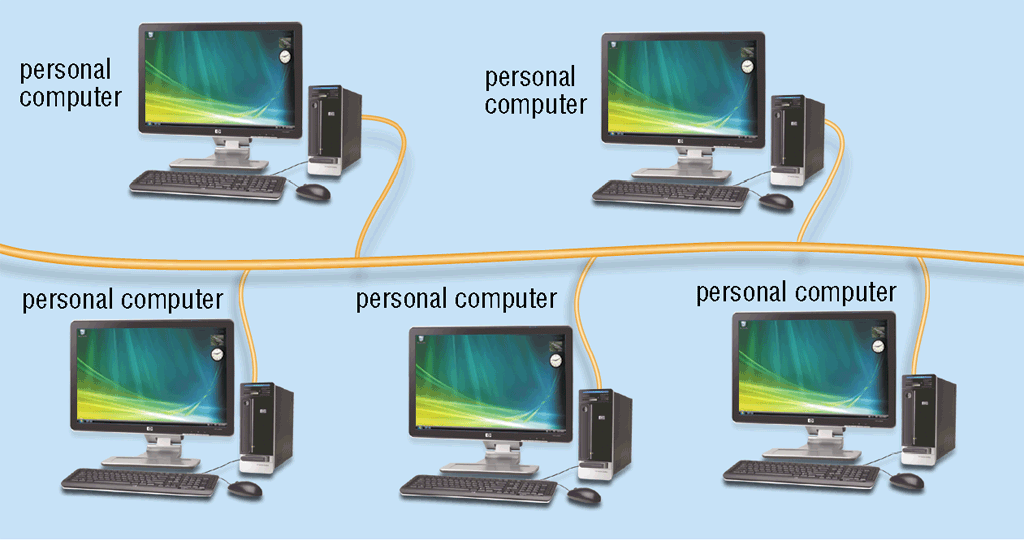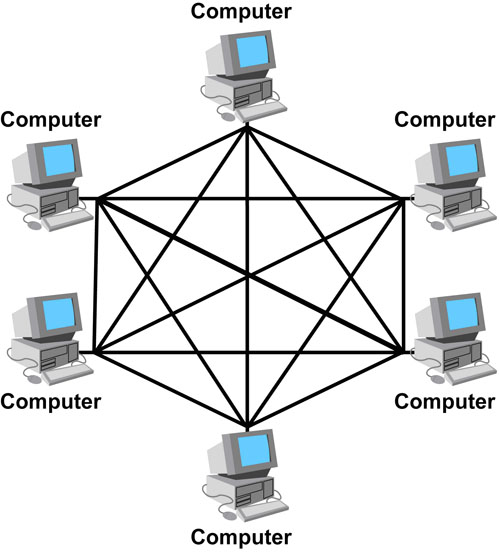
Network Topology
A topology is the physical configuration of a network that determines how the network's computers are connected. Common configurations include the bus topology, linear bus, mesh topology, ring topology, star topology, tree topology and hybrid topology. See each of these topology definitions for additional information and visual examples.

Is the arrangement of the various elements of the computer network. Essentially, it is the topological structure of a network, and may be depicted physically or logically.
There are 5 different types of network Topologies commonly used in communication systems.
These Include:1. Linear Bus Topology
2. Star Topology
3. Ring Topology
4. Mesh Topology
5. Hybrid Topology

Linear Bus Topology

A type of network topology in which each device is connected one after the other in a sequential chain (shown right). In this case, the bus is the network connection between the devices, and if any link in the network chain is severed, all network transmission is halted.

It works well for small networks because it is simple to set up and utilizes shorter cables since each device is connected to the next. It is a poor solution for larger networks, however since the entire network relies on each connection, and network speed is reduced as more devices are added.

It works well for small networks because it is simple to set up and utilizes shorter cables since each device is connected to the next. It is a poor solution for larger networks, however since the entire network relies on each connection, and network speed is reduced as more devices are added.
Star Topology

One of the most common network setups. In this configuration, every node connects to a central network device, like a hub, switch, or computer. The central network device acts as a server and the peripheral devices act as clients. Depending on the type of network card used in each computer of the star topology, a coaxial cable or a RJ-45 network cable is used to connect computers together.

Uses a central device called HUB with cables extending in all directions. Each networked device is connected directly to the hub. Data from a computer passes through the hub or switch before it can reach the other target node. One of its advantages is the lack of disruptions to the network when connecting or removing devices; however, if the hub fails, attached nodes will not be able to use the network resources.
One of the most common network setups. In this configuration, every node connects to a central network device, like a hub, switch, or computer. The central network device acts as a server and the peripheral devices act as clients. Depending on the type of network card used in each computer of the star topology, a coaxial cable or a RJ-45 network cable is used to connect computers together.

Uses a central device called HUB with cables extending in all directions. Each networked device is connected directly to the hub. Data from a computer passes through the hub or switch before it can reach the other target node. One of its advantages is the lack of disruptions to the network when connecting or removing devices; however, if the hub fails, attached nodes will not be able to use the network resources.
Ring Topology

A network configuration in which device connections create a circular data path. Each networked device is connected to two others, like points on a circle. Together, devices in a ring topology are referred to as a ring network.

In a ring network, packets of data travel from one device to the next until they reach their destination. Most ring topologies allow packets to travel only in one direction, called a unidirectional ring network. Others permit data to move in either direction, called bidirectional.
Mesh Topology

Hybrid Topology

A type of network topology that uses two or more differing network topologies. These topologies include a mix of bus topology, mesh topology, ring topology,and star topology.
A network configuration in which device connections create a circular data path. Each networked device is connected to two others, like points on a circle. Together, devices in a ring topology are referred to as a ring network.
In a ring network, packets of data travel from one device to the next until they reach their destination. Most ring topologies allow packets to travel only in one direction, called a unidirectional ring network. Others permit data to move in either direction, called bidirectional.
Mesh Topology

A network setup where each computer and network device is interconnected with one another, allowing for most transmissions to be distributed, even if one of the connections go down. It is a topology commonly used for wireless networks.

In a full mesh topology, every computer in the network has a connection to each of the other computers in that network. The number of connections in this network can be calculated using the following formula (n is the number of computers in the network): n(n-1)/2

In a partially connected mesh topology, at least two of the computers in the network have connections to multiple other computers in that network. It is an inexpensive way to implement redundancy in a network. In the event that one of the primary computers or connections in the network fails, the rest of the network continues to operate normally.

In a full mesh topology, every computer in the network has a connection to each of the other computers in that network. The number of connections in this network can be calculated using the following formula (n is the number of computers in the network): n(n-1)/2

In a partially connected mesh topology, at least two of the computers in the network have connections to multiple other computers in that network. It is an inexpensive way to implement redundancy in a network. In the event that one of the primary computers or connections in the network fails, the rest of the network continues to operate normally.
Hybrid Topology

A type of network topology that uses two or more differing network topologies. These topologies include a mix of bus topology, mesh topology, ring topology,and star topology.

Sources:
https://whatis.techtarget.com/definition/network-topology
https://www.computerhope.com/jargon/l/linear-bus-topology.htm
https://www.computerhope.com/jargon/s/startopo.htm
https://www.computerhope.com/jargon/r/ringtopo.htm
https://www.computerhope.com/jargon/m/mesh.htm
//www.computerhope.com/jargon/h/hybrtopo.htm
No comments:
Post a Comment